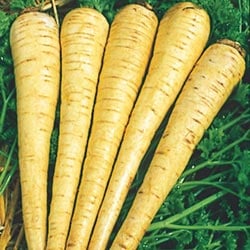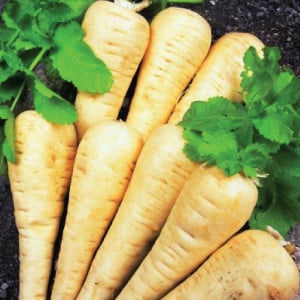
Learning Download: How to Grow Parsnips
From Seed to Harvest: A guide to growing parsnips.
Parsnips are a root vegetables that look similar to a carrot, though they are paler in color and have a stronger taste. Parsnips have a long growing season and should be planted as soon as the soil can be worked.
To plant:
Sow seeds 1/2 inch deep and 1 inch apart in soil mixed with compost. Seedlings will begin in two to three weeks. Parsnips also can be started inside, where you can mix the seeds with compost in a bag and then tie off the bag. Leave the bag in a warm, dark place and seedlings should sprout within a week. After they’re sprouted, transplant the seedlings to the garden.
To grow:
Once seedlings appear, thin them to 3 to 6 inches apart. Parsnips require 1 inch of water per week and full sun. With their green tops, parsnips can reach 3 feet high so plant in an area where the shade won’t harm other plants. Parsnips do best in soil with a pH of 6.0 to 6.8.
To harvest:
Parsnips take approximately 16 weeks to mature, and their flavor is enhanced by enduring a few frosts. Parsnips also can be left in the ground throughout the winter and then harvested in the spring. If leaving the parsnips in the ground, cover thickly with mulch. To harvest, trim the leaves to 1 inch above the root. Loosen the soil with a fork and carefully pick the roots. Roots can reach up to 12 inches long and 2 inches in diameter.
What parsnips crave:
Prior to planting, spread compost or manure across the planting site and mix it with the soil. Fertilization can be done by using a 10-10-10 fertilizer and working it into the soil with a fork, as root vegetables do best growing in fluffy soil. Apply a side dressing of fertilizer six weeks after planting the parsnips.
Where to buy parsnip seeds:
You can find parsnip seeds at Urban Farmer.
Learning Download: Common pests and diseases: Parsnips
Common pests and diseases: Parsnips
When growing vegetables, it is always exciting to care for the plant throughout its growing phase and then harvest it for delicious recipes later on, but one thing to watch out for is pests and diseases. Different plants are susceptible to different types of pests and disease, and it is important to make yourself aware so you can keep a watchful eye and also take any preventative methods to keep your plants safe throughout their lifespan.
Parsnips can fall victim to several different pests and diseases.
Pests:
Some common pests affecting parsnips include aphids, the beet armyworm, the carrot rust fly and the cutworm.
Aphids will be soft-bodied insects usually showing up on the undersides of the leaves. They will be green or yellow in color. The aphids secrete a sticky substance which can cause mold. Knock the aphids off the leaves with a jet of water. Only use insecticides if the infestation is out of control.
The best armyworm will cause singular or multiple closely group holes in the foliage of the plant. Apply Bacillus thuringiensis and encourage natural enemies.
The carrot rust fly will cause surface scarring of the plant’s taproot by creating tunnels, which will be filled with a rust-colored mush. It also attacks carrots and celery. Use row covers to manage this insect and don’t leave parsnips in the ground over winter.
The cutworm will cause the stems of young plants to be severed at the soil line. If the plant is older, there will be irregular holes eaten into the fruit. To prevent this insect, remove all crop residue after harvest and fit foil collars around the plant stems.
Diseases:
Common diseases affecting parsnip plants include cavity spot, downy mildew, Itersonilia canker and more.
Cavity spot is a fungal disease that will cause the plant to develop sunken, gray lesions on the root and small vertical cracks. Flooded soils can increase the possibility of this fungus, and once it is developed, the fungus can exist in the soil for years. To prevent this disease, do not over fertilize and apply appropriate fungicides.
Downy mildew will cause the plant to develop yellow spots on the upper parts of the leaves, and there will be a fluffy white growth on the undersides of the leaves. The lesions will become darker over time. This disease is more likely to occur if there has been prolonged leaf wetness. To prevent this disease, don’t overcrowd plants and practice crop rotation.
Itersonilia canker will cause the plant to develop brown necrotic lesions with green halos. It will usually emerge late in the growing season and to reduce it, cover the shoulders of the parsnip roots with soil throughout its growing season. Practice crop rotation and remove weeds, plow crop debris after harvest and plant in well-draining soils.


